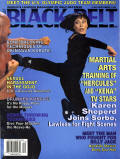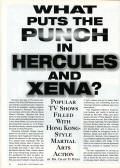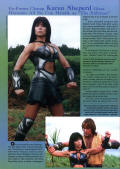September 1996
What Puts the Punch Into Hercules & Xena
Not since the days of The Green Hornet and The Wild, Wild, West have American television audiences been treated to the kind of an energetic, creative pugilism demonstrated in “Hercules: The Legendary Journeys, and its spin-off series Xena: Warrior Princess. Hercules and Xena have not only quickly emerged as two of the top-rated syndicated television shows in the United States, but have done so by entrusting their success to, of all things, the wild-and-wooly, frenetic-paced action formulas of Hong Kong film.
Executive producer Robert Tapert, known for his work in Jean-Claude Van Damme’s Hard Target and Timecop, explains the reasons for this strange twist. “I’ve always been impressed with the Hong Kong cinema style of action,” he says, “so with Hercules, we initially tried to emulate that style. In fact, when we pitched the idea for Xena, I made a demo reel of four Hong Kong movies to show the syndicators the kind of action sequences we wanted to do in the show. We also weren’t afraid to break the rules of fight realism and go for action that’s entertaining and something that the American television audience has never seen before.”
This imaginative blend of cross-cultural fantasy and reality is further enhanced by the fresh, exotic and spectacular scenery of New Zealand, where the two series are shot. Set in the golden age of Greek mythology, Hercules (played by Kevin Sorbo) uses his wits, courage and strength to defend the poor, virtuous and downtrodden, and in doing so, is forced to battle an outrageous array of demons, beasts and gods bent on destroying him. Similarly, Xena (played by Lucy Lawless) righteously battles barbaric tribes, slave traders and dregs of the Earth in her mission to free the oppressed from the clutches of injustice and tyranny.
The man responsible for serving up this mouth-watering menu of mayhem is the show’s stunt coordinator, Peter Bell, who is known for his work on films such as Savage Island, Mutiny on the Bounty and Willow.
“Although Kevin and Lucy are not [serious] martial artists, most of the stunt team are boxers and martial artists, and they have to be good fall guys,” Bell relates. “In order for a fight to work, you’ve got to have the stunt people sell the hit. Things like flying through the air and somersaults can make a fight look far more visual. If people who watch the fight cringe after a guy hits the deck, then it’s a good fight.”
Sorbo, who practices white lotus kung fu when time permits, is a refreshing break from actors who claim martial arts “mastership” merely because they are stars of action-oriented shows. “People can identify with Hercules; they find him a very approachable hero, someone who is attainable,” Sorbo states. “You can walk up to him and feel comfortable.”
Although the training schedule is tough, and he suffers from the usual injuries associated with this style of show, Sorbo gladly embraces the Hong Kong-type action. He is up at 4:30 a.m., films for 12-14 hours, then returns home to train with weights, practice fighting maneuvers, and study his lines. “I sleep maybe five hours if I am lucky,” he says. “I’ve seen the Hong Kong [action films]; they are crazy. We have that style of action, and our own tongue-in-cheek humor, but the scripts have strong dramatic elements. I do 90 percent of all my stunts, and I think the ‘stunties’ can respect me for that.”
Tapert proposed the Xena spin-off show to Universal officials based on the character of the same name who appeared in three top-rated episodes on Hercules. Lawless is a New Zealand-born ex-gold miner from the Australian outback who starred in the film Hercules and the Amazon Women.
“Xena is as strong as any man or woman has ever been,” Lawless says of her character. “She’s sort of dysfunctional and knows about the dark side of human nature. She is actually the person I could have been if I had been born to different parents.”
Lawless particularly enjoys her work in the show’s fight scenes. “Usually I get more out of doing dialogue, but when I see the results of the fights on the screen, it’s just so rewarding,” she says.
She admits the physical requirements of her role are demanding. “Oh man, it’s incredibly strenuous,” Lawless relates. “It’s one hell of a challenge to achieve some sort of balance, so that I am not too tired to do good acting, yet remain flexible enough to do the fights and certain jumps. I do weight training, boxing, and I love my kung fu classes. As a kid, I was always uncoordinated, but I have overcome that with my martial arts training. I’ve only practiced a couple of months. It’s a start, and I enjoy learning.”
According to stunt coordinator Bell, one of the keys to a successful fight scene is adding emotion to the techniques. “There’s only so many techniques you can put in a fight, so we bring out the emotions of a fight by using different camera angles and speeds,” he explains. “When Hercules hits someone, he sends him flying. For that effect, we’ll either use ‘jerk harnesses,’ ‘jerk rams’ or and ‘air ram’ to launch the assailant through the air. The air rams can throw someone 10-12 feet up or 20-30 feet out. When Hercules picks someone up and hangs them by their ankles or carries him around like a shield, we just use simple wire rigs. All these things can help me change the look of the fights.”
Sorbo, while enjoying the fight scenes, wishes he had more time to prepare for them. “We don’t get enough time to choreograph and practice the fights,” he claims. “I learn most of this stuff on the day we are going to be doing it. It’s just go, go, go. Once that camera starts rolling, I’m thinking ‘What am I doing?’ I’ve got a sword in one hand and a torch in the other, and I’m about to go through 40 guys. I’m amazed when it’s over that I did it. Doing this show is fun for me; it’s like being a kid again. I used to play Hercules and Superman [as a kid]. Even after seeing Bruce Lee I would run about the backyard and ‘kung fu’ everything. Reliving those fantasies is a fantasy.”
They may be newcomers to the martial arts, but Lawless and Sorbo already have their share of “war stories” to exchange with others. Lawless received a black eye during one scene, and recounts another difficult episode. “I had gotten whacked and apparently the bones on the top of my back were quite severely [out of alignment],” she relates. “My head was off to one side. For nine days, I couldn’t concentrate, my sinuses were gone and my vision was affected. It was difficult because I didn’t know why I couldn’t do anything. I really just had no energy. But these things can happen. We go extremely fast; there is almost no time to rehearse, except between takes. But the ‘stunties’ are fantastic - it’s like working with a dancing partner. Plus, I’m feeling more comfortable with the swords and fighting with that ‘boomerang thing’ (a chakram - a razor-sharp, discus-size throwing thing).”
Bell takes great care to prevent Lawless’ fight scenes from becoming clones of Sorbo’s fights. “The nature of their fights are different,” he explains. “Lucy’s are more martial-artsy, so for her fights we use a lot of wire rigs, where she can run up or flip backwards off trees, or run along walls sideways. With Kevin, we use more air rams, swings and jerk rams. With either actor, it’s not good to put in too many fancy kicks in the fights, because I’ve got to make it look like they’re really doing it. However, with some kicks, I can get them to start the kick, then a double can finish it.”
“Peter is aware of my limitations,” Lawless adds. “It’s only recently that I’m getting better at just forgetting my limits, tapping into my body, and just going for it. In fact, in one show there’s this neat fight where I run along the side of a wall and do this fancy leg-pumping flying kick.”
Often referred to as a “Hong Kong film-kick” or “no shadow kick,” this movie technique was invented by Hong Kong film-maker Ching Siu Tung, for use against one or 50 opponents at a time. Such a kick is perfect for the Hercules and Xena series, in which one individual=7F frequently fights large groups of opponents rather than a series of one-on-one confrontations.
The shows are also noted for their special effects, which are the inspiration of Ray Harryhausen, who was responsible for the effects in Jason and the Argonauts, Valley of Kwangi and the Sinbad movies. The earlier episodes of Hercules featured puppetry effects, but eventually the leap was made to computer-generated images.
The man in charge of bringing giant snakes, three-headed dogs, half-human snake demons, centaurs and sword-wielding skeletons to life, is visual effects supervisor Kevin O’Neill, known for his work on Dracula and Cliffhanger. Perhaps his best work on the show is a scene which pits Hercules against eight sword-wielding skeletons, which was adapted from a memorable scene in Jason and the Argonauts.
“What we did was buy a skeleton model, then modify it to match the eight skeletons that we planned to use in the three-dimensional animated fight sequence,” O’Neill says. “I first had eight guys put together a fight and rehearse the sequence, then we filmed it once with the guys and once with just Kevin fighting by himself.”
Sorbo recalls the scene well. “It was wild seeing this thing put together,” he says. “First the stunties went through the entire fight sequence, strike for strike, and filmed it as one big master shot so the computer guys could see what it was going to look like. Then I did the fight by myself [against no opponents], copying the exact moves. Then I did it a third time tight, with the [special effects] guys operating the skeletons’ arms and legs. Then the computer guys got a hold of it and pieced it together. I’m always amazed at what they do.”
Each of the shows has an average of three big fight scenes in each episode, meaning Bell must coordinate about six fights a week. “I’ve got to create at least one new movement per fight, then just basically rehash the old ones and make them look different,” he says.
Adds Tapert: “Although we wanted to emulate Hong Kong’s style of action in Hercules, we quickly found out that we couldn’t incorporate a lot of the acrobatics because we felt it was out of character for ‘Herc.’ I love the fights in Xena, but Herc’s fights are getting a bit dull and too repetitive. It’s hard with a guy who punches people to continue to come up with new brawls that are interesting. We are continuing to try, but are being careful not to use too many
*
Many thanks to Kym Taborn for the transcript






